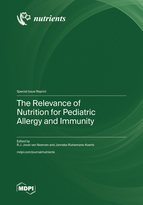The Relevance of Nutrition for Pediatric Allergy and Immunity
A special issue of Nutrients (ISSN 2072-6643). This special issue belongs to the section "Nutritional Immunology".
Deadline for manuscript submissions: closed (31 October 2022) | Viewed by 45768
Special Issue Editors
Interests: mucosal immunology; allergy; asthma; food allergy; nutrition; dairy
Special Issues, Collections and Topics in MDPI journals
Special Issue Information
Dear Colleagues,
The purpose of this Special Issue, “The Relevance of Nutrition for Pediatric Allergy and Immunity”, is to provide an overview of the role of the relevance of nutrition in early life to support immune development to prevent infections and the development of allergy.
The development of the immune system in early life is essential to shape an immune system that can provide immunity against infection, and that does not allow the development of allergies. The first three years (or 1000 days) seem to be crucial for the development of the immune system.
The prevalence of asthma, rhinitis and food allergy has increased tremendously in recent decades. The increase in food allergies and the chance of the development of other allergies with a negative impact on the quality of life have urged us to understand the way immune systems can be influenced at an early stage.
Different factors have been known to influence the development of the immune system of the newborn in order to respond to infection, but also to tolerate food allergens; these range from breast feeding and nutrient supplementation to the shaping of the microbiota and their metabolic activities. On the other hand, the early introduction of highly allergenic foods can also prevent food allergies and induce tolerance.
What are the immunomodulatory mechanisms of these nutritional factors? Can nutrition also play an active role in immunotherapy? Can nutrition help protect against gastrointestinal and respiratory tract infections in early life?
This Special Issue will touch upon the many aspects that relate to nutritional pediatric allergy and immunity, with a focus on three different questions:
- Can nutrition in early life help to prevent (food) allergies?
- Can early life nutrition help to support immune development and prevent infections?
- What is the role of the early introduction of food components in the prevention of food allergies?
The topics covered should range from epidemiology, breastfeeding and early life nutrition, to effects on microbiota, infection, allergy, asthma, and the mechanisms of immunomodulation by (the early introduction of) nutrition on infections and the development of (food) allergies.
Kind regards,
Prof. Dr. R.J. Joost van Neerven
Dr. Janneke Ruinemans-Koerts
Guest Editors
Manuscript Submission Information
Manuscripts should be submitted online at www.mdpi.com by registering and logging in to this website. Once you are registered, click here to go to the submission form. Manuscripts can be submitted until the deadline. All submissions that pass pre-check are peer-reviewed. Accepted papers will be published continuously in the journal (as soon as accepted) and will be listed together on the special issue website. Research articles, review articles as well as short communications are invited. For planned papers, a title and short abstract (about 100 words) can be sent to the Editorial Office for announcement on this website.
Submitted manuscripts should not have been published previously, nor be under consideration for publication elsewhere (except conference proceedings papers). All manuscripts are thoroughly refereed through a single-blind peer-review process. A guide for authors and other relevant information for submission of manuscripts is available on the Instructions for Authors page. Nutrients is an international peer-reviewed open access semimonthly journal published by MDPI.
Please visit the Instructions for Authors page before submitting a manuscript. The Article Processing Charge (APC) for publication in this open access journal is 2900 CHF (Swiss Francs). Submitted papers should be well formatted and use good English. Authors may use MDPI's English editing service prior to publication or during author revisions.
Keywords
- Allergy
- Asthma
- Breastfeeding
- Early life nutrition
- Epidemiology
- Food allergy
- Early food introduction
- Food immunotherapy
- Gastrointestinal infection
- Immune development
- Infant
- Maternal diet
- Mechanism
- Microbiota, SCFA and other metabolites
- Milk
- Nutrition
- Tolerance (oral)
- Respiratory infection
- Toddler








